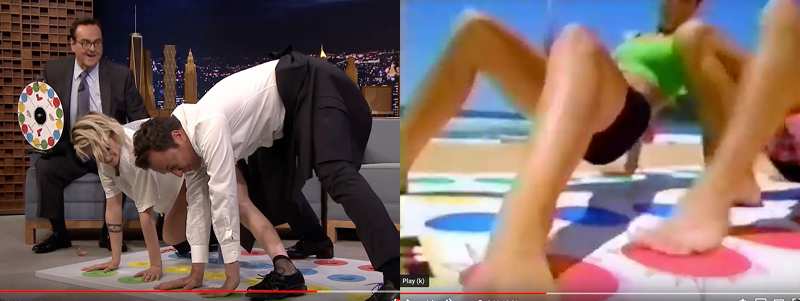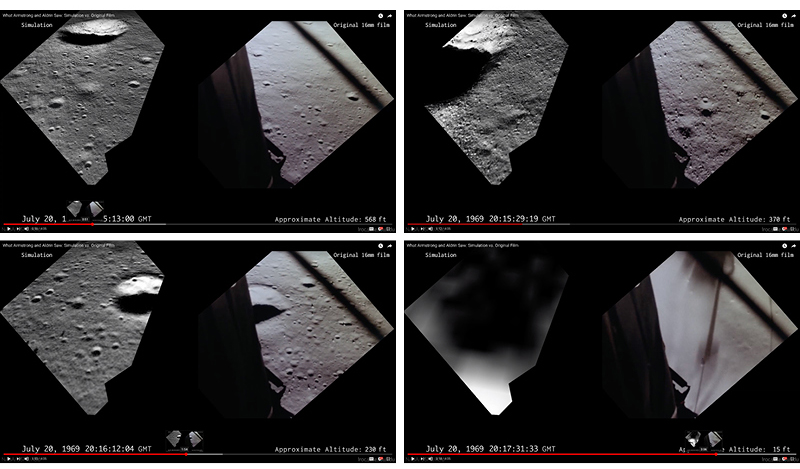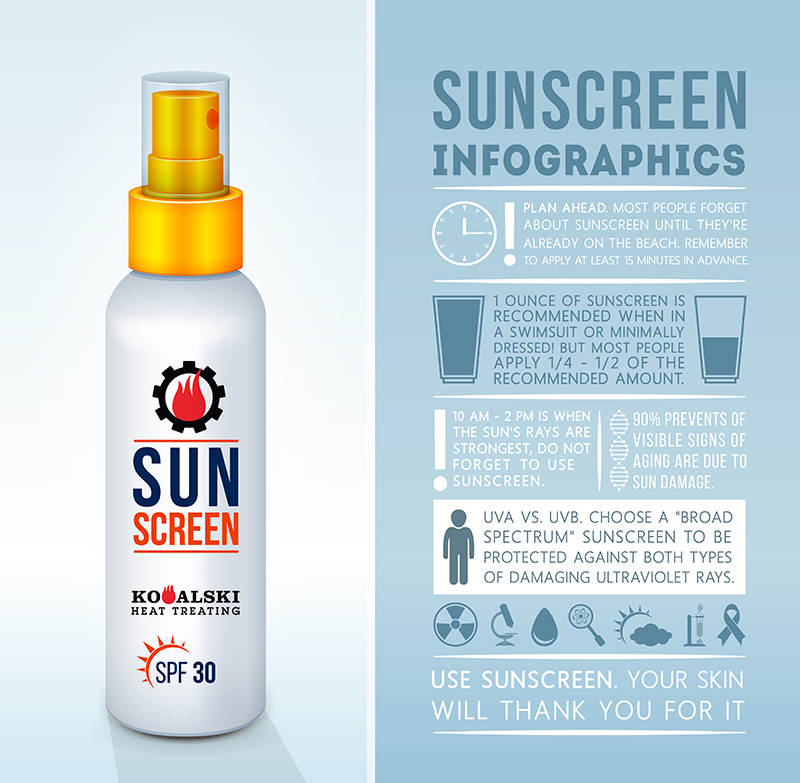Pretzel

(top left & center) An early Twister box lid and the spinner; (top right) Finger Twister! (row two, l to r) A giant Twister matt; And a giant inflatable, bouncy Twister; (row three l to r) Make your own Twister board with washable paints and chalks on grass, asphalt or concrete; (row four l to r) Twister game board costume; Twister morph-suit; Twister leggings; Twister sox—gotta get me some of them; (row five l to r) Twister duvet cover; Twister spinner key chain; (row six l to r) A really bad and scary twister; A tongue twister; A really bad and not so scary 1996 movie called Twister staring Helen Hunt and some guy; (row seven) Twister fun can be had anywhere you have enough space; (row eight l to r) Johnny Carson shows the world how to play Twister with guest Eva Gabor in 1966. See below for what the current Tonight Show host did with Twister; A Monsanto trade ad featuring a crowded twister game to promote their new additive for deodorant soaps. (bottom) The hot new Kowalski Heat Treating version of the Twister game board!
Driving home the other day I saw a bunch of kids playing on their front lawn, and it took me back to my kid days again. We had so much fun growing up – Mom would say – “get outside and get some fresh air – just be home before the street lights come on” … what freedom we had. On rainy days I’d have my buddies over to play inside. One of our favorite games was Twister – getting all tied up and laughing all the while. Then fast forward a “few” years and my own girls would be playing the same game, having a great time figuring things out! Little did I know back then, I’d be the chief “twister fixer” for my customers, taking products and projects that are all tied up, working out the kinks and enjoying myself along the way. We call this solving your PIA (pain in the @%$) Jobs! Most of the time I watch my teams “on the colored dot mat”, working together, testing and retesting, until things are just right. Now, occasionally we fall down, but the beauty of my team and life in general is not falling down because that’s going to happen, rather it’s getting back up that makes my folks so great! I found out Twister was based on a project that inventor Reyn Guyer was working on originally as a promotion for Johnson’s shoe polish company. Guyer created a polka dot paper mat and then thought it would be better as a game. He tested this with a group of office workers, which were divided into two teams, and called it ‘Pretzel’. 50 years later, we’re still enjoying his genius. Enjoy!
- In 1964, Reyn Guyer owned and managed a design company which made in-store displays for Fortune 500 companies. While working on designing a promotion for his client, the S.C. Johnson Company, his son, Reyn Jr., developed the idea that a game could utilize people as playing pieces on a life-sized game board. His first attempt he called “Kings Footsie”, but when he showed it to the 3M Company, who had a line of up-scale board games, they rejected the idea.
- Charles Foley, was a respected and successful toy designer for Lakeside Industries in Minneapolis and answered an ad for an experienced toy designer by Reynolds Guyer Sr. of Guyer Company. After interviewing Foley, Guyer and his son discussed the possibility of starting a small division of the company in product development. His father agreed, for a short term, to support his son’s idea for product development, and hired Foley, who negotiated a royalty agreement with Guyer Company for all games and toy items designed by Foley. Guyer Company agreed, and officially hired Foley. Foley hired Neil Rabens, an accomplished product design artist with an art degree from the Minneapolis School of Art and Design.
- The game ideas ranged from small kids’ games to word games for adults. Foley had an idea for utilizing people as a part of the game idea, “a party game”. Rabens had the idea to utilize a colored mat, allowing people to interact with each other, in a game idea he had developed while a student in design school. Foley saw the idea and developed the concept for having the colored dots line up in rows, and, with a spinner, created the idea for calling out players’ hands and feet to the colored dots called out from the spinner. This would create a tangled-up situation between two people, and the one that falls first would lose.
- Foley and Neil Rabens submitted for patents (US Pat# 3,454,279) and trademark rights for what was originally called “Pretzel”. Foley, with his extensive experience in the toy industry, called on his good friend, Mel Taft, Sr. V.P. for Milton Bradley in 1966, for a product idea presentation.
- In the fall of 1965, Foley and Guyer Jr. took the game to the Milton Bradley Company in Springfield, MA where Mel Taft, the senior vice-president of R & D, chose Pretzel as the best of the eight game ideas. Mel found there was a trademark problem, so he changed the game’s name to Twister, and Milton Bradley began to market it in 1966. It was the first game on store shelves that used players as the playing pieces.
- When the Milton Bradley Company found that several major retailers refused to stock the game, Taft called Foley to tell him that they were cancelling their television advertising and pulling the product from the store shelves. What executives at Milton Bradley did not know was the public relations company Mel had hired had already been paid. So, he let the plan to have Twister played on the Tonight Show go forward.
- On May 3, 1966 Johnny Carson, the host of the Tonight Show, was enticed by the Twister mat and demonstrated the game along with actress Eva Gabor. The next morning there were 50 people standing in line to buy the game at Abercrombie & Fitch where a few games had not been returned. Three million Twister games were sold in the following year. Several spin-off games have followed over the years such as: Twister Moves, Twister Dance, Twister Hoopla, and many others.
- In 1967 Twister was named the “Game of the Year”. With this success, Reynolds Guyer Sr. offered Foley and Rabens a chance to run their new toy and game development division. Mr. Foley agreed to run the Toy design company with the current royalty agreement be included in the new agreement. Reynolds Guyer Sr. wanted to dismiss any and all royalty agreements going forward. Mr. Foley did not agree with the newly proposed agreement (dismissing any and all royalty rights).
- In 1985, Hasbro acquired the Milton Bradley Company, becoming Twister’s parent company. The Reyn Guyer Creative Group continues to work closely with Hasbro to develop and market new additions to the line of Twister products, including CD’s, dancing, hopscotch, holla hoops.
- The World’s Largest Twister Mat was put together on June 18, 2010 in Bell where town, MA on the Bell where town High School football field. It consisted of 1008 Twister mats donated by Hasbro and measured 24,156 square feet. The previous record, as cited by the Guinness Book of World Records, the largest game of Twister included 4,699 square feet of mats that were combined together.
- Co-inventor Charles Foley died on July 1, 2013 at the age of 82.
- Twister tournaments are used as a source of philanthropic events put on by college fraternities and sororities to raise money for a charitable cause. Many of these Greek tournaments are held annually, and are a good way to get involved with the community
- There are publicly available instructions on how to alter a Twister game to make it accessible to color-blind individuals and to completely blind individuals.
- On May 3, 2016, the Hasbro Company began the celebration of Twister’s 50th anniversary following Reyn Guyer’s introduction of his book, “Right Brain Red”, which tells the whole tale of its beginnings.
- To learn more, visit: https://en.wikipedia.org/wiki/Twister_(game)

(left) See the Tonight Show’s Jimmy Fallon with guest Kristen Stewart face off in a game of “Jell-O shot” Twister. (right) Watch this quaint 1966 commercial promoting the new game Twister.









